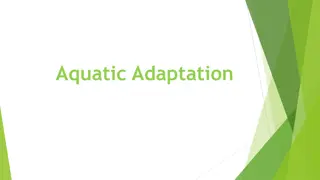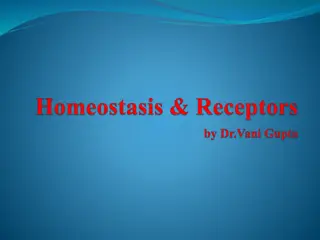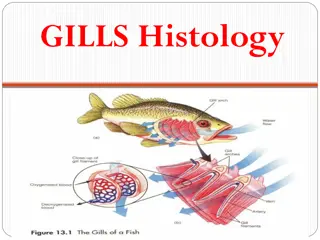
Homeostasis and Osmoregulation in Organisms
Explore the concepts of homeostasis and osmoregulation in organisms, focusing on how metabolic activity, structural features, and physiological processes enable them to maintain internal environments within tolerance limits. Learn about the importance of water as a universal solvent, essential for life and metabolic processes, as well as the role of osmoregulation in regulating water content and solutes to prevent physiological imbalances.
Download Presentation

Please find below an Image/Link to download the presentation.
The content on the website is provided AS IS for your information and personal use only. It may not be sold, licensed, or shared on other websites without obtaining consent from the author. If you encounter any issues during the download, it is possible that the publisher has removed the file from their server.
You are allowed to download the files provided on this website for personal or commercial use, subject to the condition that they are used lawfully. All files are the property of their respective owners.
The content on the website is provided AS IS for your information and personal use only. It may not be sold, licensed, or shared on other websites without obtaining consent from the author.
E N D
Presentation Transcript
HOMEOSTASIS OSMOREGULATION
SYLLABUS LINKS Changes in an organism s metabolic activity, in addition to structural features and changes in physiological processes and behaviour, enable the organism to maintain its internal environment within tolerance limits (temperature, nitrogenous waste, water, salts, and gases)
TERMINOLOGY Key Term Osmoregulation Solvent Solute hypothalamus Osmoreceptors Osmosis Diffusion Osmoregulators Osmoconformers Definition
WATER Water is the universal solvent and is essential to life. A solvent is a substance in which another substance (known as a solute) dissolves.
WATER ESSENTIAL TO LIFE Most salts & minerals in organisms are dissolved & broken into ions by water so they are ready for metabolic processes Metabolic reactions occur in a solution mainly of water Blood plasma is 90% water Required to transport reactants & products of metabolism Supply nutrients & waste Low water concentrations Makes it difficult to regulate solvent & solute concentrations Toxic waste will not be excreted efficiently Enzyme function affected
WATER Water is Essential! Metabolic processes occur in water Removal of waste Blood plasma that transports products/wastes 90% water
OSMOREGULATION DEFINITION Osmoregulationis the active regulation of an organism s water content. Balance the uptake and loss of water and solutes Controlled movements of solutes between internal fluids and the environment
EFFECT ON BODY WHEN WATER IS NOT REGULATED It maintains the fluid balance (water gain and loss) and the concentration of electrolytes (ionic solutes, or salts in solution) and other solutes that will keep the fluids from becoming too diluted or too concentrated. If the supply of water does not replace what is being lost, the relative concentrations of solutes and solvent in tissue fluids become difficult to regulate. Physiological functions are then affected.
SUMMARY OF EFFECTS OF OSMOREGULATION Affects internal pH, metabolite concentration, waste management Affects compositions of internal body fluids Hemolymph (invertebrates), interstitial fluid Maintains composition of cytoplasm in cells
WATER IS GAINED & LOST Drinking Consuming food Metabolic Water (by product of cellular respirtation) Sweating Evaporation from body surface Evaporative loss in exhaled air from panting and Rapid breathing Urination & Faeces
OSMOSIS when the surroundings have a lower solute concentration than the cellular environment. when the surroundings are of equal concentration to the cellular contents, so that there is no net movement of water. when the surroundings have a higher solute concentration than the cellular environment.
TRANSPORT Water is transported via osmosis & solute molecules are actively transported
HOMEOSTASIS OSMOREGULATION - ADAPTATIONS IN AQUATIC ENVIRONMENTS
TWO METHODS OF OSMOREGULATION IN AQUATIC ENVIRONMENTS Osmoconformers Marine animals are isosmotic with environment They maintain an internal solute concentration similar to their environment Do not regulate their osmolarity Osmoregulator Freshwater, marine that adjust internal osmotic pressure by actively controlling the salt concentrations within the body
OSMOREGULATORS & OSMOCONFORMERS Osmoregulators vs Osmoconformers Osmoregulators are organisms that firmly regulate their body osmotic pressure by actively controlling the salt concentrations within the body irrespective of the salt concentration of external environment. Osmoconformers are organisms that live in the marine environment and thus have the ability to maintain the internal body osmotic pressure irrelevant to that of the external environment. Type of Organisms Osmoregulators include both marine fish and freshwater. Osmoconformers mainly include many marine invertebrates. Energy Expenditure Osmoregulators use a high amount of energy than osmoconformers. Osmoconformers use a low amount of energy when compared to osmoregulators.
ADAPTATIONS OF FISH (OSMOREGULATORS) Factor Marine bony fish Freshwater bony fish Problems Loses too much water via osmosis across skin. Gains too many salts via drinking seawater and eating food. Gains too much water via osmosis across skin and when eating food containing water. Loses too many salts via diffusion and in urine.
MARINE & FRESHWATER FISH Draw how Marine & Freshwater fish maintain water & salt balance https://www.youtube.com/watch?v=Dtsen_YNwVk&list=PLsMs3sjjy- pCcR8l3ohnIUhIiCwEjQB6K&index=43
ADAPTATIONS OF FISH (OSMOREGULATORS) Factor Marine bony fish Freshwater bony fish Problems Loses too much water via osmosis across skin. Gains too many salts via drinking seawater and eating food. Gains too much water via osmosis across skin and when eating food containing water. Loses too many salts via diffusion and in urine. 1 Does not drink water. (Fish swim with mouth open so water passes by their gills for gas exchange, but they do not swallow.) 2 Low level of reabsorption in kidneys 3 Excrete high volumes of dilute urine 1 Gain salts when eating food 2 Active uptake of salts from seawater across gills Adaptations for water balance 1 Constantly drinking sea water. 2 Eating food containing water 3 High level of reabsorption in kidneys 4 Excretes a low volume of highly concentrated urine Adaptations for salt balance 1 Excretes highly concentrated urine, ridding the body of excess salts 2 Active transport of salts from salt- secreting cells in gills to the seawater
MARINE FISH
F R E S H W AT E R F I S H
MARINE FISH OSOMOREGULATION SUMMARY
FRESHWATER FISH OSOMOREGULATION SUMMARY
Pacific salmon spend part of life in fresh water and salt water OSMOREGULATION EXAMPLE FROM EXAMS They are able to regulate water content within their bodies in these different osmotic environments
ACTIVITIES Biology WA Units 3 & 4 Set 11.4 pg 383 Q 1 5
OSMOREGULATION IN AQUATIC OSMOREGULATION IN AQUATIC ENVIORNMENTS ENVIORNMENTS Water Essential to life Osmoregulators Freshwater Bony Fish Osmosis in Animal Cells Hypotonic Isotonic Hypertonic Osmosis in Plant Cells Hypotonic Isotonic Marine Bony Fish Hypertonic Osmoconformers



















